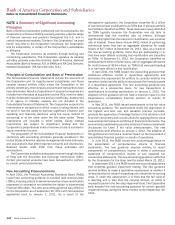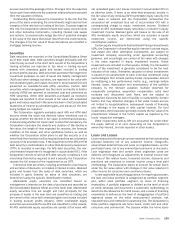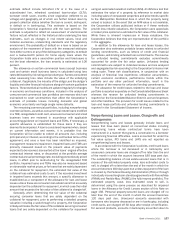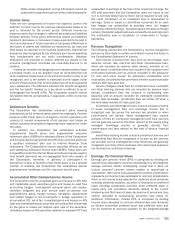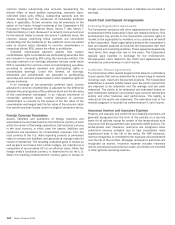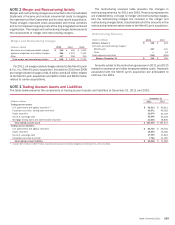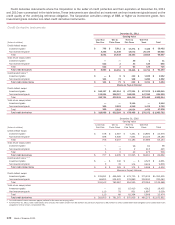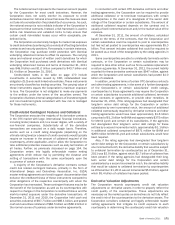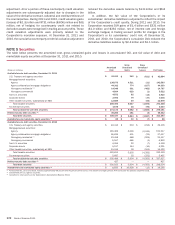Bank of America 2011 Annual Report Download - page 164
Download and view the complete annual report
Please find page 164 of the 2011 Bank of America annual report below. You can navigate through the pages in the report by either clicking on the pages listed below, or by using the keyword search tool below to find specific information within the annual report.162 Bank of America 2011
common shares outstanding plus amounts representing the
dilutive effect of stock options outstanding, restricted stock,
restricted stock units (RSUs), outstanding warrants and the
dilution resulting from the conversion of convertible preferred
stock, if applicable. Certain warrants may be exercised, at the
option of the holder, through tendering of the Corporation’s 6%
Cumulative Perpetual Preferred Stock, Series T (the Series T
Preferred Stock) or cash. Because it is currently more economical
for the warrant holder to tender the Series T preferred stock, the
common shares underlying these warrants are considered
outstanding and the dividends on the preferred stock are added
back to income (loss) allocable to common shareholders in
computing diluted EPS, unless the effect is antidilutive.
Unvested share-based payment awards that contain
nonforfeitable rights to dividends are participating securities that
are included in computing EPS using the two-class method. The
two-class method is an earnings allocation formula under which
EPS is calculated for common stock and participating securities
according to dividends declared and participating rights in
undistributed earnings. Under this method, all earnings,
distributed and undistributed, are allocated to participating
securities and common shares based on their respective rights to
receive dividends.
In an exchange of non-convertible preferred stock, income
allocated to common shareholders is adjusted for the difference
between the carrying value of the preferred stock and the fair value
of the consideration exchanged. In an induced conversion of
convertible preferred stock, income allocated to common
shareholders is reduced by the excess of the fair value of the
consideration exchanged over the fair value of the common stock
that would have been issued under the original conversion terms.
Foreign Currency Translation
Assets, liabilities and operations of foreign branches and
subsidiaries are recorded based on the functional currency of each
entity. For certain of the foreign operations, the functional currency
is the local currency, in which case the assets, liabilities and
operations are translated, for consolidation purposes, from the
local currency to the U.S. dollar reporting currency at period-end
rates for assets and liabilities and generally at average rates for
results of operations. The resulting unrealized gains or losses as
well as gains and losses from certain hedges, are reported as a
component of accumulated OCI on an after-tax basis. When the
foreign entity’s functional currency is determined to be the U.S.
dollar, the resulting remeasurement currency gains or losses on
foreign currency-denominated assets or liabilities are included in
earnings.
Credit Card and Deposit Arrangements
Endorsing Organization Agreements
The Corporation contracts with other organizations to obtain their
endorsement of the Corporation’s loan and deposit products. This
endorsement may provide to the Corporation exclusive rights to
market to the organization’s members or to customers on behalf
of the Corporation. These organizations endorse the Corporation’s
loan and deposit products and provide the Corporation with their
mailing lists and marketing activities. These agreements generally
have terms that range from two to five years. The Corporation
typically pays royalties in exchange for the endorsement.
Compensation costs related to the credit card agreements are
recorded as contra-revenue in card income.
Cardholder Reward Agreements
The Corporation offers reward programs that allow its cardholders
to earn points that can be redeemed for a broad range of rewards
including cash, travel and discounted products. The Corporation
establishes a rewards liability based upon the points earned that
are expected to be redeemed and the average cost per point
redeemed. The points to be redeemed are estimated based on
past redemption behavior, card product type, account transaction
activity and other historical card performance. The liability is
reduced as the points are redeemed. The estimated cost of the
rewards programs is recorded as contra-revenue in card income.
Insurance Income and Insurance Expense
Property and casualty and credit life and disability premiums are
generally recognized over the term of the policies on a pro-rata
basis for all policies except for certain of the lender-placed auto
insurance and the guaranteed auto protection (GAP) policies. For
lender-placed auto insurance, premiums are recognized when
collections become probable due to high cancellation rates
experienced early in the life of the policy. For GAP insurance,
revenue recognition is correlated to the exposure and accelerated
over the life of the contract. Mortgage reinsurance premiums are
recognized as earned. Insurance expense includes insurance
claims, commissions and premium taxes, all of which are recorded
in other general operating expense.


